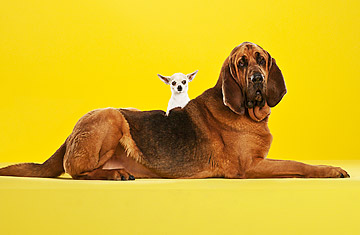
(5 of 7)
One of the most provocative implications of these studies is that friendships that evolved within species may sometimes reach across the species barrier. In her best-selling book Unlikely Friendships, journalist Jennifer Holland describes many such surprising pairs--a gorilla and a kitten, a cheetah and a dog, a hamster and a snake. YouTube, a decidedly more ad hoc source, is filled with clips of cross-species buddies.
But what you see onscreen may be less authentic than it seems. Barbara King, an anthropologist at the College of William and Mary and the author of Being with Animals, thinks a lot of these cases reflect wishful thinking more than actual friendships. "Right now the label is being applied far too broadly and uncritically," she says.
For King, it's not enough that two animals spend time near each other or greet each other enthusiastically. She'd use the term friendship only if the animals put some effort into their relationship--by grooming, for example. Few of the relationships that you can find online meet King's standard, even those in which a predator gets cozy with an animal that might ordinarily be prey. Predators aren't on the prowl all the time, King points out, and they use a lot of cues such as the size and fitness of potential prey to determine if it's worth trying to go for a kill.(This might help explain the popular on-line clip of a cat that seems to befriend a crow--a very large and very smart bird that would not succumb easily.)
Still, even King admits to being taken by the story of Mzee the tortoise and Owen the hippo. Owen was found as a 1-year-old alone and dehydrated near the coast in Kenya in 2004. He was put in an enclosure at a wildlife sanctuary with the 130-year-old Mzee. To the surprise of the park managers, the two animals became inseparable. They slept and ate together, and Mzee would sometimes lick Owen's face. King is especially impressed by how the two animals communicate. "Mzee nips Owen's tail to nudge Owen along on a walk. Owen nudges Mzee's feet when he wants to do the same," she says. "Owen's nudging is quite specific: he nudges Mzee's back right foot when he wants Mzee to steer right and the opposite for going left." Unfortunately, scientists can't draw any deep lessons from a single pair of animals. King speculates that the young Owen simply sought protection and comfort from Mzee. "The need for close contact can be very powerful," she says. "If that need isn't being met by one's own kind, more normal responses may be swamped."
Another question that studies of animal friendship inevitably raise is how all this applies to our favorite nonhuman species: dogs. Despite what we might suspect, the science so far does not rank canines very high on the friendship scale.
"Pet dogs do form friendship-type relationships with other dogs in the same household," says James Serpell, director of the Center for the Interaction of Animals and Society at the University of Pennsylvania. "Dogs that socialize regularly in dog parks also seem to prefer to hang out with particular preferred canine companions."
